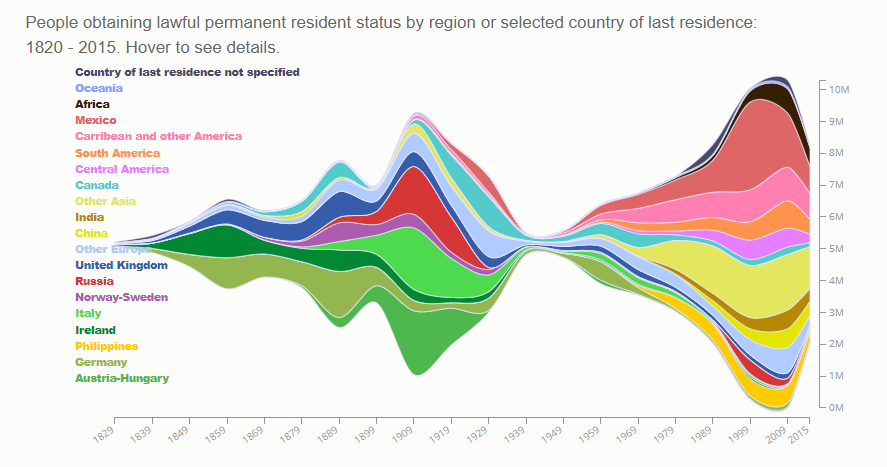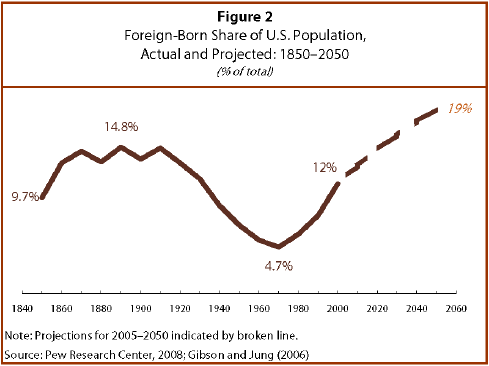The Long View 2006-05-24: The Next America

Lawful immigrants over the past 200 years

Pew Hispanic Share of US Population that is Foreign Born
Here are a couple of graphs to help illustrate John Reilly's points here. If we would really like to emulate the success of the last large wave of immigration to the United States, from roughly 1840 to 1930, it would be prudent of us to stop, and give everyone time to get used to each other. It took a lot of work last time, and it will this time too.
The Next America
A book published eleven years ago by Michael Lind speaks to our condition today: The Next American Nation: The New Nationalism and the Fourth American Republic . Indeed, let me suggest that before going any further in this blog entry that you read my review of the book, here. There is a link at the end of the review to bring you back.
All done?
You will note that the review is not uncritical. I don't think there is going to be another American Revolution, unless you count Reconstruction and the New Deal as revolutions. Also, I would suggest that the years since I wrote that review have proven that Lind's dismissal of the religious element in American culture is an unfruitful hypothesis, particularly for someone who hopes to reform the political system to make it more congruent with the national character. Moreover, I think that his notion of an "Overclass" is just one step above David Icke's lizard people. Still, the immigration issue has so changed things that time runs short in which to decide what in this sort of analysis is really prescient. For those slackers who did not read the review, consider this paragraph:
Lind is particularly exercised about the Overclass's nearly unanimous support of free trade. He notes that family income has been stagnant at best for the last twenty years, and that wages per worker have actually declined. Part of this he blames on the decline of unionization among the workforce, which he attributes almost entirely to government hostility. The rest he blames on foreign competition. The Overclass, in Lind's view, has deliberately and successfully driven down the wages of the average American since the late 1970s. This was achieved not only by permitting the import of foreign goods, but by actually importing foreign workers. The author spends a great deal of space trying to show that America historically has experienced heavy immigration only in spurts, all of which produced bad feeling, and which hindered the process of assimilating people already here. Multicultural America is gradually being transformed into a province of the Third World. The Overclass itself, however, dreams of becoming a post-American global elite.
Again, time has tested Lind's ideas, and in the matter of free trade I think they have been found wanting. At any rate, neither NAFTA nor the WTC have caused the disasters that were forecast: quite the opposite. Neither is it true that the globalists are responsible for keeping the borders open. From what I can tell, the political force behind that is generally conservative, even isolationist, middle-range businessmen and farmers who don't see why relegating the manual trades to a special caste of aliens should be a problem. In other words, a large part of the political dynamic is the local notables who, collectively, are far more influential than big business. Lind is worth reconsidering, however, because he foresaw that immigration would be important not just as a depressor of wages, but also because it threatens cultural dilution on an unprecedented scale.
Thus, I think that Mary Ann Glendon's piece, Principled Migration, which appears in the June/July issue of First Things, badly misapprehends the situation. She notes:
Good-faith anxieties about large-scale immigration are sometimes expressed in terms of social costs, such as a feared deleterious effect on the nation's cultural cohesion or the stability of local communities. One would like to take comfort from the fact that similar concerns were expressed at the time of the great migrations of a century ago. Though marked by conflict and competition, the story of those earlier immigrants is, to a great extent, a story of integration.
She then goes on to note some ways in which integration has become more difficult. The Democratic political machines, for instance,
that once brought new citizens into the political process at the local level have vanished. In their place...[the] newcomer from Mexico, Brazil, or El Salvador becomes a generic "Latino" in preparation for initiation into the game of divisive racial minority politics.
Particularly worrisome to her as a lawyer is that whereas "there is no place on Earth where legal values play a more prominent role in the nation's conception of itself than the United States," the 11 million or 12 million illegals "come from societies where formal law is associated with colonialism: and who, as a consequence, "may well find the United States' emphasis on legality rather strange." The earlier immigration did not threaten the rule of law; that immigration was legal.
All good points, but they are not the half of it. Glendon wholly neglects the fact that the earlier immigration succeeded because it ended. In contrast, she does not contemplate an end to the current immigration, or even a diminution. She asserts, without argument, that the United States requires "replacement immigration" to make up for the children who were not born because of 40 years of anti-natalist public policy. She deplores that policy, but does not address the possibility that high immigration is the one measure sure to keep it in place.
Worst of all is that she looks to the Catholic hierarchy for guidance, particularly the 2003 Joint Pastoral Letter issued by the Mexican and U.S. bishops, Strangers no Longer: Together on a Journey of Hope. (Why is it that the church social-documents most likely to cause misery and violence always have the most inanely irenic titles?). There we read this remarkable principle:
III. Sovereign nations have the right to control their borders. 36. The Church recognizes the right of sovereign nations to control their territories but rejects such control when it is exerted merely for the purpose of acquiring additional wealth. More powerful economic nations, which have the ability to protect and feed their residents, have a stronger obligation to accommodate migration flows.
One might compare this with the Catechism of the Catholic Church (section 2241):
foreigner
Note that it's hard to see how someone with a right to residence can be considered a guest. In any case, the principle is a puzzler. Kant discerned a universal right to travel, but not to settlement. Where else the bishops might have gotten these notions is a mystery; certainly there is no serious scriptural support for the proposition, as William F. Vallicella points out at Right Reason.
For anyone so inclined, the Catechism's proviso, "to the extent that they are able," would allow ample room for limiting immigration in order to forestall the development of irredentist movements and to prevent the depression of wage levels, both of which apply in the current immigration controversy. Frankly, though, I am not much inclined to accommodate this text. The Catechism is a sound document for the most part, but it does contain multicultural flourishes that have aged very badly very fast. It is the vulnerability of advanced countries that has proven to be the more serious issue. (The Latin text was copyrighted in 1994. The previous Catechism dates from the 16th century. The update was precipitous, it seems.)
As for the Pastoral Letter: well, bishops' conferences say the damnedest things.
Copyright © 2006 by John J. Reilly




Comments ()